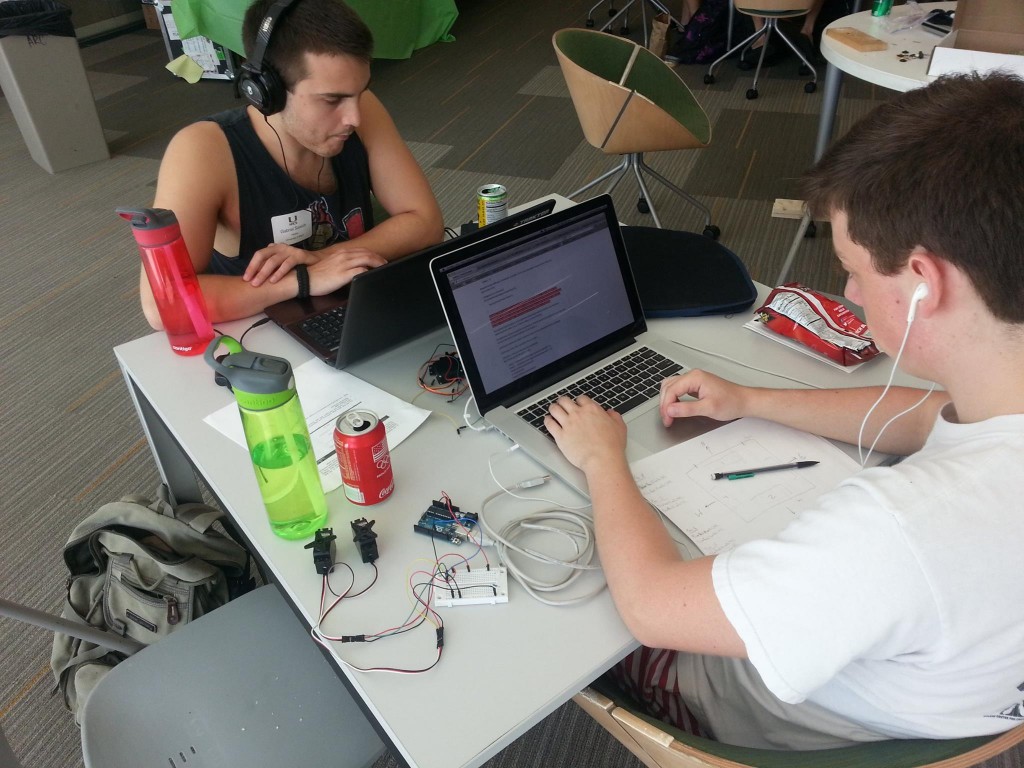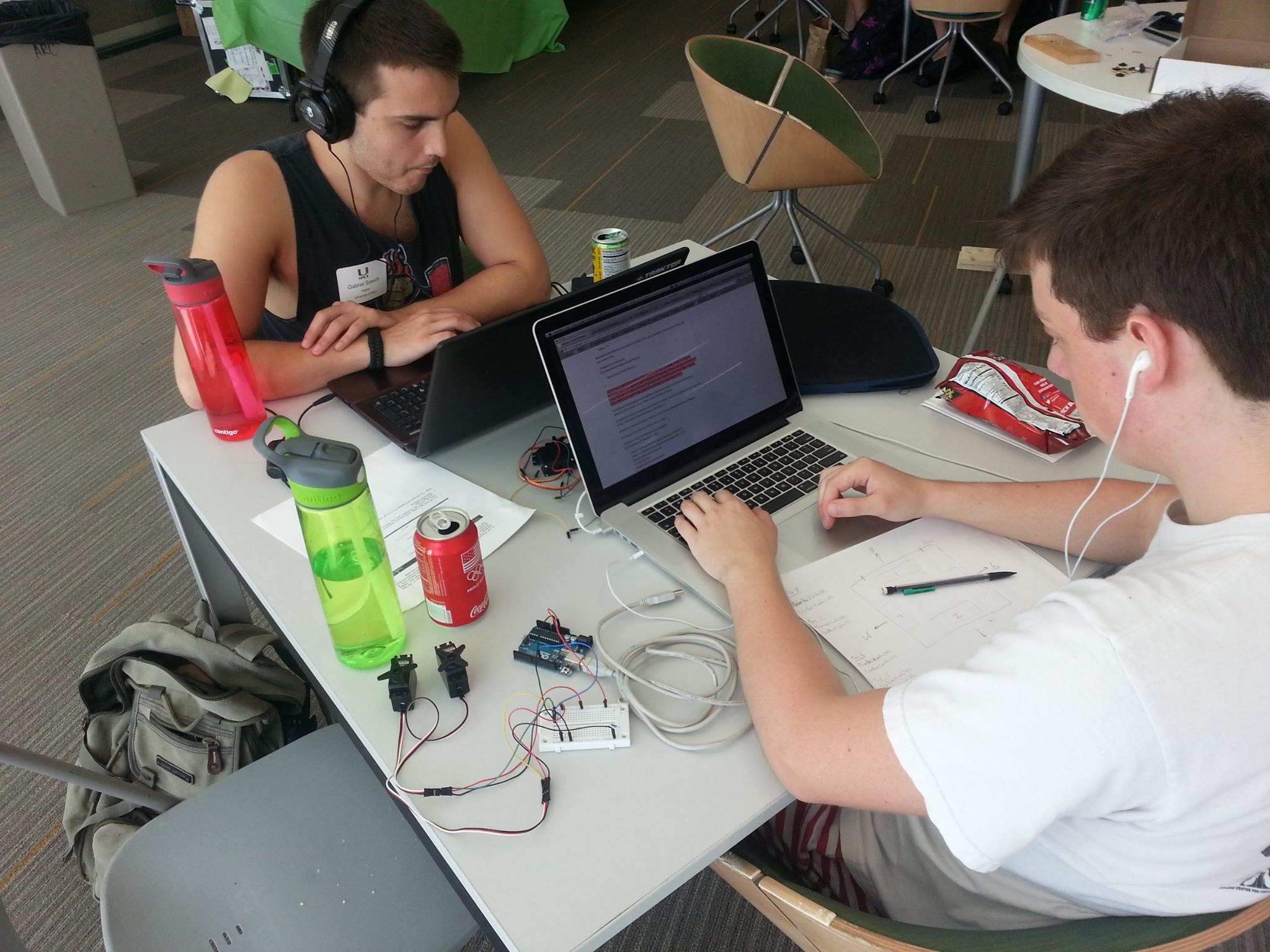
[dropcap]T[/dropcap]he atmosphere of the Student Activities Center (SAC) Ballroom is both quiet and electrified as the clock crawls through an early Sunday afternoon. Empty soda cans, blankets and wires are strewn across the floor. Ringing through the air is the hum of intense discussion and the muted energy of over a hundred students running on dubious amounts of sleep, caffeine, catered food and adrenaline.
This is UHack, the University of Miami’s fourth annual hackathon, a 24-hour marathon of brainstorming, problem-solving and attempting to develop viable software. UHack kicked off Engineers Week (E-Week) this past weekend.
Hackathons are what passionate coders live for, but as these focused innovation efforts continue to prove their practical advantage in addition to their recreational appeal each year, they are gaining a larger and more varied following.
The backing for hackathons has burgeoned over these past few years. Indications of this include the appearance of organizations like Major League Hacking (MLH), which was founded in 2012 and sanctions collegiate hackathons like UHack. According to its website, MLH seeks to provide mentorship and expertise to college organizers. Other networks, like Hacker League or large Facebook pages like Hackathon Hackers, help groups organize their own hackathons, find hackathons to attend and swap tips and tricks of the coding trade.
According to avid programmers, programming in real life does not always resemble our glamorized computer-savvy misconceptions.
Rather, hacking is collaborative – not the work of a single “computer wiz.” Successful projects are often the result of brainstorming and collaboration, as with any traditional business project.
“Programming is very collaborative, we work together,” UHack 2015 Chair Alex Ruhlman said. He is a sophomore majoring in software engineering.
“It’s not just some guy sitting in the basement,” he said.
A hackathon’s format allows groups of skilled individuals to congregate in one place, where all of their needs – snacks, water and even air mattresses – are taken care of. This leaves teammates with only their ideas to focus on for the next 24 to 48 hours.
Programming can also be practical and accessible. In the past two to three years, there has been a push to develop programming literacy through initiatives like an Hour of Code, which started in 2013 by a nonprofit called Code.org. Activities offered on the website include “Code with Anna and Elsa,” and an Angry Birds coding overview.
While games like these can be effective and exciting introductions to programming, Ruhlman emphasizes that these are only springboards for individuals who want to further their coding ability.
“I think they’re really good at introducing people. But they’re designed to be accessible; they’re designed to be easy enough for anyone to do, yet entertaining enough to keep people interested,” Ruhlman said. “If you look at what you’re actually doing [in most of those programs], it’s only about seven hours of work at a very beginner level.”
[dropcap]R[/dropcap]uhlman cautioned against the image that coding can be easily dabbled in as a casual hobby. Rather, he compared it to learning an instrument. While many have the potential to master the skill, he said, achieving fluency requires the same discipline that it takes to differentiate between a pair of hands playing “Chopsticks” on the piano, and another performing Rachmaninoff.
“Coding isn’t just something that you can just do and then get,” he said. “It take years and years of problem-solving skills. It’s up to you and how far you want to take it.”
Likewise, hackathons are opportunities for beginning programmers to advance their introductory skills. UHack includes activities for a spectrum of skill levels, including challenges and video game modifications for beginners. There are even places for those with no coding skills at all.
“When I went to EDHackathon, [a small event at] LAB Miami, I saw that you don’t need a lot of programming experience to enjoy this event,” Ruhlman said. “If you’re in public relations, and you want to make an app more user-friendly and appealing, if you’re in graphic design, if you’re in communications; these are all useful skills to have.”
According to Ruhlman, these accessible activities make the prospect of participating in a hackathon much less daunting.
“Once you get the hang of it, it’s really fun to see what you can do with code,” Sabrina Anand, a freshman in biomedical engineering, said.
She recently learned the C++ and MATLAB programming languages as part of her introductory engineering class last semester.
“I would be interested in doing something like UHack, just to see how far I could go with my skills,” she said.
For more advanced coders, hackathons like UHack can offer more than just a chance to show off programming prowess and compete for valuable prizes; they also offer promise of eager investors and recruiters.
Jon Oringer, CEO of stock photo company Shutterstock, praised hackathons in a 2013 interview with the New York Times.
“It pushes a lot of thinking. It’s pretty amazing what people can get done in 24 hours,” he said. “Sometimes we talk about a new product feature and it can take three months to build. Then someone will prototype it overnight.”
[dropcap]A[/dropcap]s hackathons have become increasingly popular, UHack has also grown with the trend. The first UHack took place in 2012 in the Macarthur Engineering building with only 28 registered participants. Last year’s hackathon event was moved to the University Center with most of the 75 participants from the South Florida area.
This year, the over 120 participants registered were students from not only Florida but from all over the United States. There were participants from the Southeast, New England, the West Coast and even a handful from Canada.
Besides sponsorship from big names like Google, Microsoft and Sony, UHack also received local support from software startups like Kairos and the LAB Miami. Hackers enjoyed sponsored challenges, swag and prizes.

This was also the first time that UHack has received sanctioning from an international league like MLH, which provided advice and guidance to UHack’s organizers. UM’s event is still modestly sized compared to hackathons like HackMIT, PennApps and Stanford University’s TreeHack, but Ruhlman believes that UHack’s “geographical uniqueness” as an MLH foothold in Florida could be an advantage when it comes to developing a similarly well-established event that will draw in hackers from around the world.
“It’s not going to be immediate; it’s going to take multiple years,” he said. “[But] we’re the biggest event that happens at E-Week. I think UHack sets E-week apart, and perhaps UHack can help our E-Week grow.”
Ruhlman cites logistical concerns as the biggest limiting factors to UHack’s event. He said UM’s campus does not currently have a venue large enough for a hackathon on the same scale as the ones mentioned earlier. In addition, he said unlike many other flagship hackathons, UHack does not have the budget to pay for participants’ transportation.
The support from MLH and the UM College of Engineering has, however, been encouraging. Ruhlman described a “domino effect” of support that started with the presidents of UM’s Institute of Electrical and Electronics Engineers (IEEE). He also mentioned that Ann Helmers of the Engineering Advisory Board and the Dean James Tien of the College of Engineering were important resources for UHack.
[dropcap]T[/dropcap]his year’s UHack theme was “Hack for a Better U,” and hackers were instructed to create apps that improved daily life. The UHack committee, a small group of six, chose this theme not only because it expressed school pride but because it was also incredibly flexible.
“It’s basically [an idea] to make projects on any platform, for the benefit of improving your lifestyle, because that’s really what technology is,” said Ruhlman. “It doesn’t just have to be traditional lifestyle applications; it could be word processing. It’s a tricky way of saying you can do whatever you want.”
Even so, the top performers at UHack were traditional lifestyle products that utilized Zensah-sponsored fitness equipment.
A UM team took home second place with software that keeps track of the intensity of a workout using an armband. The 2015 UHack champions was a high school team of four who won the competition with a similar armband application called Xenfit.
At the basis of Ruhlman’s work is a strong passion for the “coding ethos” that groups like MLH want to spread. One of the programmers he admires the most is Jason Zimmerman, a professional Super Smash Brother player.
“The way he got that edge was that he took the game discs, downloaded all the files, then learned on his own and looked at frame data about how the game worked, dissecting the game, and because of that he got that little 1% tactical advantage, after about 5 years of dissecting the games, he was able to win world championships for Super Smash Bros,” said Ruhlman. “That’s the beautiful thing about what hacking is, it can be whatever you want.”
The coding craze, however, will not end once E-Week is over. Before the Clinton Global Initiative University (CGIU) event on March 5, students will have the opportunity to participate in the Clinton Foundation Codeathon.
According to a press release sent out by UM Media, the Codeathon will “challenge developers and designers to build unique digital prototypes inspired by CGI U Commitments to Action in the areas of Education, Global Health, and Environment & Climate Change.”
The event will culminate with team presentations to a panel of judges who work in the fields of technology and social innovation.
Featured image courtesy UHack






